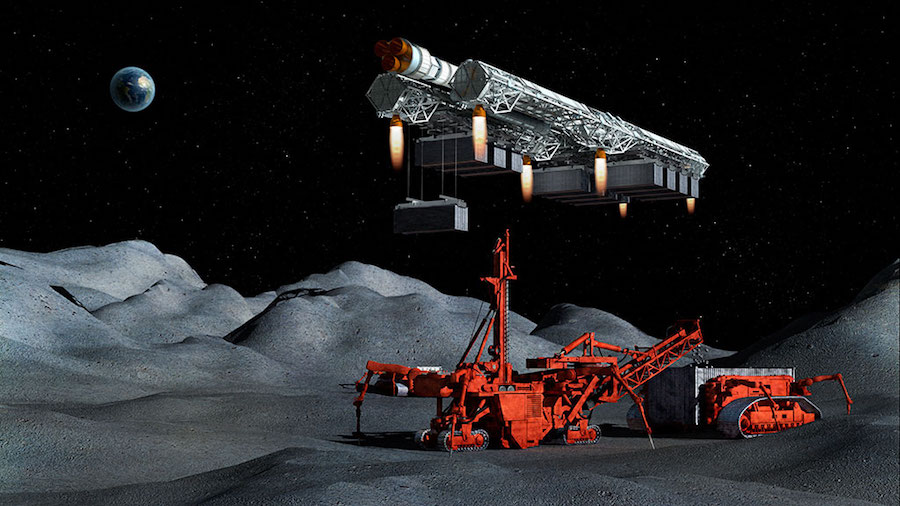Global S&T Development Trend Analysis Platform of Resources and Environment
| The global race to mine outer space | |
| admin | |
| 2020-05-22 | |
| 发布年 | 2020 |
| 语种 | 英语 |
| 国家 | 国际 |
| 领域 | 地球科学 |
| 正文(英文) |  Digital rendition of a mining operation in space. (Source: Mine Stories)
Both interest in and financial commitments to space activities, in particular around the moon, by governments, space agencies and the private sector have surged in recent years. The asteroid mining market is already valued at up to trillions of dollars, but a single drill from earth has yet to make it to space. While space mining is a concept still out of this world to some, it is real for the mining industry. After long being considered mostly science-fiction, governments are now implementing programs and legislation that allow them to join the race for mining in space. Dr. Carlos Espejel is a mining industry veteran and current Space Resources Utilization Engineer at ispace, a private commercial lunar exploration company with offices in Luxembourg, the first European country to offer a legal framework ensuring private capitals their rights over resources they mine in space, and Tokyo. ispace builds the transportation technology needed to make it to the moon. ispace was the managing company of team Hakuto, one of five finalists in the Google lunar Xprize competition, which called for privately funded teams to be the first to land a robotic spacecraft on the moon, travel 500 meters, and transmit hi-definition video and images back to earth.  “We can actually land instruments and payloads on the lunar surface. We have the capabilities to travel and land on the moon, Espejel told MINING.COM. “We can transport and land instruments on the lunar surface. Our exploration technologies – rovers and landers – will carry instruments for the exploration of resources, like Lunar H2O and oxygen.” Espejel said the moon is the first area the company has focused on in space. The second area is resource and reserves evaluation, as well as the acquisition of exploration data. “From previous missions led by space agencies as NASA, JAXA, ESA, and ISRO, we have data and knowledge of certain elemental distributions on the lunar surface, and we know there are a lot of potential resources,” he said. Mining the moon’s resourcesispace has two moon missions planned – the first for 2021, M1, putting a rover on mixed latitudes, and in 2023 – a mission planned to the south pole. For these missions – ispace has already booked and paid for the flights with Elon Musk-founded Space X. “We know there is plenty of aluminum, calcium, silicon, iron, magnesium, thorium, uuranium, and abundance of potassium, rare earth elements and phosphorous. One of the latest and most exciting human discoveries we have so far, however, is the H2O (water) or hydroxides at the lunar poles – a lot of it, in the form of permafrost and/or ice,” Espejel said.
“We now know the locations of these water deposits on the poles of the moon. It has been estimated that there is anything from 3 to 10s of billion metrics tonnes of H2O. “Right now, because of this knowledge, there is an outer space race between US, Russia, China and India – they are all going for these H2O deposits and strategic areas on the moon for permanent outposts. Because it is like fuel… when splitting H2O into H and O hydrogen and oxygen can be used for energy purposes, as rocket fuel and fuel cells. This year, there are three missions to the moon. China will be landing on the moon this year in a purely robotic remote control mission to bring samples back to earth.” Espejel said India will also be going to the south pole of the moon this year, for the second time in history. “The mission is to confirm existence of water on the south pole among many other scientific goals, and NASA, later next year will be taking its Orion spacecraft to lunar orbit for six days.” Human missions getting closerThere is a current ambition from space agencies to build permanent bases on the lunar surface in the near future, mainly close to the south pole.
Espejel said the possibility of human missions is getting closer, and NASA’s Artemis program is envisioning sending humans back to the Moon as early as 2024. Two robotic missions are happening this year. ispace works with space agencies as the Luxembourg Space Agency, the European Space Agency (ESA), the Japanese Space Agency (JAXA), and is currently competing for NASA payloads in the CLPS program as part of Team Draper. The mining industry has standard codes for the reporting and estimation of mineral resources and reserves such as JORC, NI-43-101 and CRISCO. “We are currently working with partners to establish the first standard code for space resources, (LORS), said Espejel, who co-authored the paper. “The Hague is putting together building blocks for the use of space resources, based on United Nations (UN) definition of ownership [and] licenses. It will work like international waters. No ownership, but in safe zones with no interference.” Espejel said building blocks will be used to amend the Moon Treaty, which is on the table at the UN. “As soon as the UN sees the race to the moon’s south pole – it is going to speed up on the situation,” Espejel said. |
| URL | 查看原文 |
| 来源平台 | Minging.com |
| 文献类型 | 新闻 |
| 条目标识符 | http://119.78.100.173/C666/handle/2XK7JSWQ/270996 |
| 专题 | 地球科学 |
| 推荐引用方式 GB/T 7714 | admin. The global race to mine outer space. 2020. |
| 条目包含的文件 | 条目无相关文件。 | |||||
| 个性服务 |
| 推荐该条目 |
| 保存到收藏夹 |
| 查看访问统计 |
| 导出为Endnote文件 |
| 谷歌学术 |
| 谷歌学术中相似的文章 |
| [admin]的文章 |
| 百度学术 |
| 百度学术中相似的文章 |
| [admin]的文章 |
| 必应学术 |
| 必应学术中相似的文章 |
| [admin]的文章 |
| 相关权益政策 |
| 暂无数据 |
| 收藏/分享 |
除非特别说明,本系统中所有内容都受版权保护,并保留所有权利。
修改评论